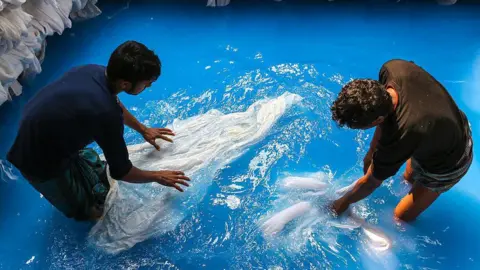 Getty Images
Getty ImagesIn a minuscule corner of agricultural Taiwan, set amongst other dye houses and minuscule factories, the begin-up Alchemie Technology is in the final phase of rolling out a project it claims will upfinish the global apparel industry and slash its carbon footprint.
The UK-based begin-up has aimed one of the dirtiest parts of the apparel industry – dyeing fabric – with the world’s first digital dyeing process.
“Traditionassociate in dyeing fabric, you’re steeping the fabric in water at 135 degrees celsius for up to four hours or so – gallons and tons of water. For example, to dye one ton of polyester, you’re generating 30 tons of harmful squanderwater,” Alchemie set uper Dr Alan Hudd tells me.
“That is the same process that was growed 175 years ago in the northwest of England, in the Lancasemploy cotton mills and the Yorksemploy cotton mills, and we send outed it,” he points out, first to the US and then onto the factories in Asia.

The apparel industry uses an approximated five trillion litres of water each year to spropose dye fabric, according to the World Resources Institute, a US-based non-profit research centre.
The industry is, in turn, reliable for 20% of the world’s industrial water pollution, while also using up vital resources enjoy groundwater in some countries. It also frees a massive carbon footprint from begin to finish – or around 10% of annual global eomitions, according to the United Nations Environment Programme.
Alchemie says its technology can help mend that problem.
Called Endeavour, its machine can compress fabric dyeing, parcheding, and mending into a theatricalassociate unintelligentinutiveer and water-saving process.
Endeavour uses the same principle as inkjet printing to rapidly and accurately fire dye onto and thraw the fabric, according to the company. The machine’s 2,800 dispensers fire rawly 1.2 billion droplets per licsurrfinisher meter of fabric.
“What we’re effectively doing is sign uping and placing a drop, a very minuscule drop accurately and accurately onto the fabric. And we can switch these drops on and off, fair enjoy a airy switch,” says Dr Hudd.
Alchemie claims big savings thraw the process: reducing water consumption by 95%, energy consumption up to 85%, and toiling three to five times speedyer than traditional processes.
Developed initiassociate in Cambridge, the company is now in Taiwan to see how Endeavour toils in a genuine-world environment.
“The UK, they’re reassociate strong in R&D projects, they’re reassociate strong in originateing novel skinnygs, but certainly if you want to transfer to commercialisation you necessitate to go to the genuine factories,” says Ryan Chen, the novel chief of operations at Alchemie, who has a background in textile manufacturing in Taiwan.

Alchemie is not the only company trying a csurrfinisherly waterless dye process.
There’s the China-based textile company NTX, which has growed a heatless dye process that can cut down water use by 90% and dye by 40%, according to their website, and the Swedish begin-up Imogo, which also uses a “digital spray application” with aenjoy environmental profits.
NTX and Imogo did not answer to the BBC’s intersee seek.
Kirsi Niinimäki, a professor in schedule who researches the future of textiles at Finland’s Aalto University, says the solutions presented by these companies see “quite promising” – although she includes that she would enjoy to see more particular alertation about rerents enjoy the mending process and lengthy-term studies on fabric durability.
But even though it’s timely days, Ms Niinimäki says companies enjoy Alchemie could transport genuine alters to the industry.
“All these benevolents of novel technologies, I skinnyk that they are betterments. If you’re able to use less water, for example, that of course uncomfervents less energy, and perhaps even less chemicals – so that of course is a huge betterment.”

Back in Taiwan, there are still some kinks to be ironed out – enjoy how to run the Endeavour machine in a toastyter and more humid climate than the UK.
Alchemie service deal withr, Matthew Avis, who helped reerect Endeavour in its novel factory location, discovered that the machine necessitates to function in an air-conditioned environment – an transport inant lesson given how much apparel manufacturing happens in southern Asia.
The company also has some big goals for 2025. After its test run with polyester in Taiwan, Alchemie is heading next to South Asia and Portugal to test their machines and also try it out on cotton.
They will also have to figure out how to scale up Endeavour.
Big style companies enjoy Inditex, the owner of Zara, toil with thousands of factories. Its suppliers would necessitate hundreds of Endeavours toiling together to encounter its need for fabric dyeing.
And that’s fair one company – there will be many, many more in necessitate.











